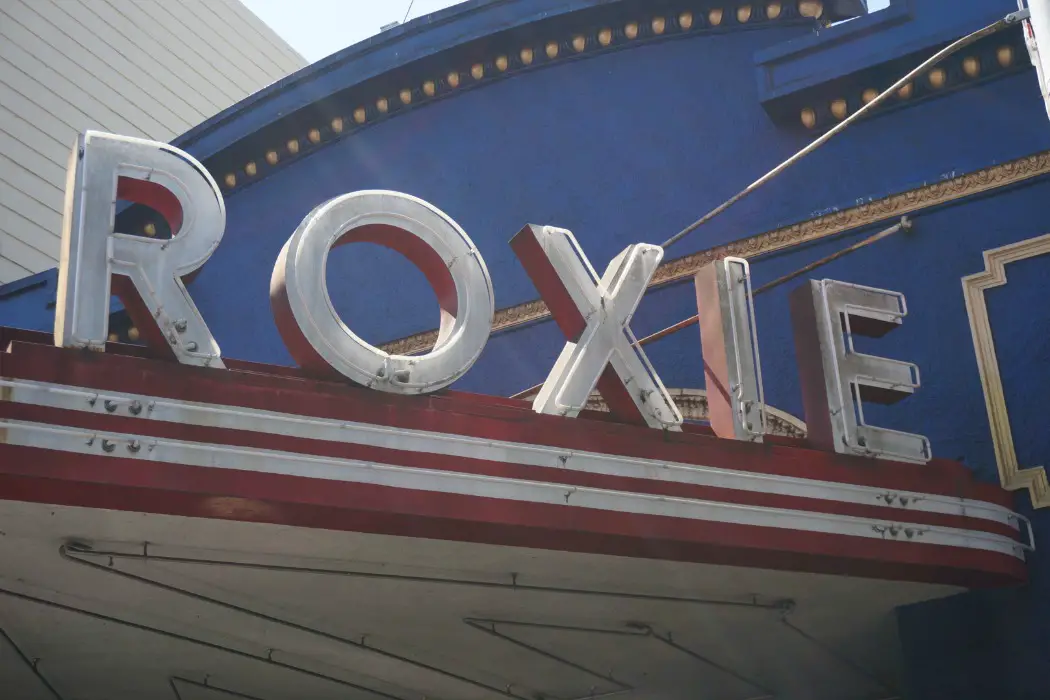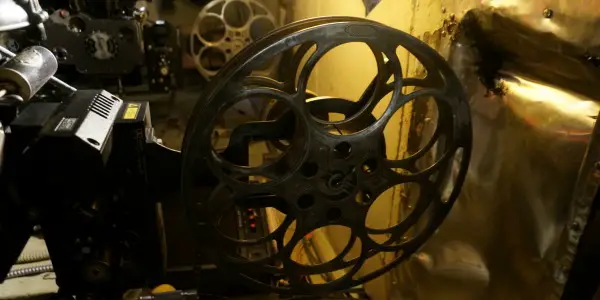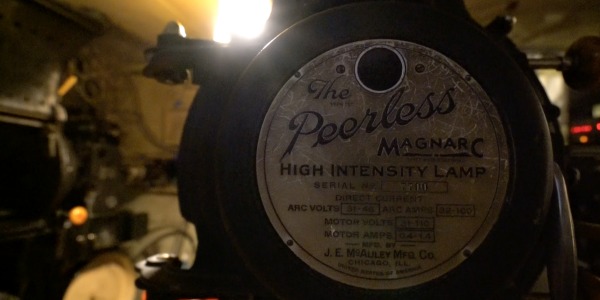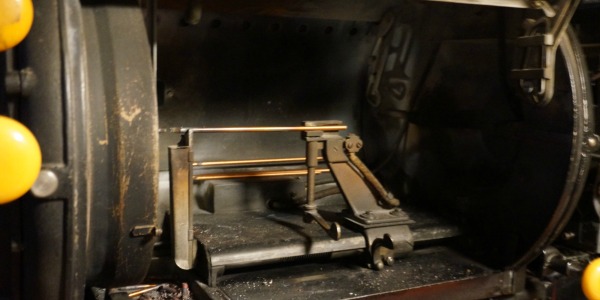The Roxie Theater, San Francisco: Arthouse Cinemas & The Timelessness Of Celluloid

Alex Arabian is a freelance film journalist and filmmaker. His…
Though celluloid has become obsolete, the demand to view 35mm and 70mm films in the format that they were made to be seen as remains strong enough to keep entire continually operated, reel-to-reel cinemas across the world projecting celluloid not only running, but thriving today. You may recognize these theaters as what they’ve become more commonly known as: Arthouse cinemas.
Perhaps the most popular name is the Alamo Drafthouse, which has capitalized on this lingering love for grainy onscreen film projections, and franchised 100s of locations around the United States. They screen both digital and celluloid films. Yet, the Drafthouses you see across the country are merely imitations of these Arthouse cinemas that once served as first-run theaters of the golden age of Hollywood.
The Roxie Theater, San Francisco
Perhaps one of the greatest examples of one of these resilient old theaters is The Roxie in San Francisco. In operation since 1909, it is the longest-running continuously-operated, reel-to-reel cinema in the United States. The Roxie Theater even uses the old carbon arc projection process, combustion, flames, and all, one of less than 100 cinemas in the world to still honor this old projection technique.
The Roxie booth has two Carbon Arc projectors, and has been preserved in its entirety since the 1930s, as has much of the interior and exterior art-deco architecture. The Roxie Theater has lived many lives since its birth, from screening the latest mainstream Hollywood films in the 1920s and 1930s, to expressly German films in the 1950s, to pornographic films in the 1960s, and back, in a way, full-circle to operating again as a cinema for film.

Now, The Roxie Theater screens old 35mm reels of classic cinema, old and modern cult classics, horror films, theatrical rereleases, local filmmaking festival screenings, and, yes, even the occasional current film! Sure, digital has become the forefront of the industry, but 35mm celluloid still accounts for over 25% of The Roxie’s revenue, according to Executive Director, Dave Cowen.
I had the opportunity to speak with Cowen about The Roxie’s storied past and perseverance, his role in rebranding The Roxie as a chic, Arthouse cinema with a multi-generational appeal, the importance and attraction of celluloid film and its relationship to cinema’s history, and why film will never truly die.
Interview with Dave Cowen, Executive Director of The Roxie
Alex Arabian for Film Inquiry: In your words, can you provide a brief history of The Roxie Theater?
Dave Cowen: The Roxie is the nation’s (U.S.) oldest continually operating cinema. It was built as a movie theater in 1909. There are some theaters that are older than us, but usually, those are venues that were live theater venues that were repurposed for cinemas, whereas we were always built as a theater.
It went through a number of different names like The Poppy, and The Gaiety, and the C.H. Brown Theater, until in 1933, [when] it was renovated, to become The Roxie. The Roxie is much like it was in 1933. The Roxie used to be a nickelodeon. It was the first run house, a second run house. For a while, it was a porn theater, then a German language theater. But in 1976, it was purchased by a collective who wanted to showcase independent and foreign films here in The Mission. And we have been showing independent and foreign films ever since.
What is your mission in pursuing reel-to-reel, brick-and-mortar theaters? What’s your background within the industry?
Dave Cowen: I actually come from the tech industry. I worked sort of in the intersection of tech and non-profit. I’ve always been a huge fan of cinema and my personal goal at The Roxie is to use my knowledge of tech and my knowledge of cinema to keep the theater, that wasn’t necessarily doing that well – The Roxie has gone through a number of near death experiences over the years – to strengthen the theater and to improve our projection, to improve our programming, to improve our promotion, and sort of invigorate the theater back to the greatness of what an arthouse theater can be.
For the theater in general, our mission is to connect San Francisco with filmmakers, primarily with independent and foreign films. And one of the things that we pride ourselves on are making in-person connections, whether that’s having filmmakers or having people speak about the films, having forums about those films. It’s important for people to get together and to discuss films, and to experience film as an audience. And really, that’s what The Roxie is all about.
How do you secure special events such as Joe Dante, Richard Kelly, Jonás Cuarón (Desierto), and countless filmmakers that come to your theater and speak with the audience? You don’t really see that interconnectivity very often today within the film industry, especially on the theatrical level.
Dave Cowen: I absolutely agree. Some of that is we do work with film distributors when a film is touring. We are known as a location that many directors ask to come to, or come to as part of their tour for a film. For example, the filmmaker tonight (Mickey Lemle) for The Last Dalai Lama, a film that we’re showing; that’s going to be showing at The Rafael and that’s going to be showing here. Sometimes filmmakers tour with their films, and we’re known as being one of the outposts of independent films.
Filmmakers often like to come to our theater because we’re neither too small nor too big; the main theater has 234 seats. There’s really a connection between a filmmaker and their audience. It’s a small space, but there’s still a lot of people. Conversations can happen more easily and I think because of that, a lot of independent filmmakers, or even larger filmmakers really appreciate the kind of connection that they can get with an audience at The Roxie.
In the case of Joe Dante and Richard Kelly, I have to be honest, both of those are directors that I personally have a passion for. And that’s one of the nice things about having that kind of reputation is that we can go out and ask a director for a special favor. So Joe was happy to come out and present his films. Richard Kelly, we had him out to show the film Southland Tales last year, about this time in July. Screening went extremely well, so we were able to have him back at The Roxie for Donnie Darko.
Those are definitely personal favorites of mine. And in both of those cases, and the same with Jonás Cuarón and some other folks who have come out to visit, those are people who we’ve asked to come out. And while we can’t pay an appearance fee, we are a non-profit, those are directors who came out to be with us just to see their films with an audience and to present their films and to connect. We’re grateful to those directors for coming out to be with us because we’ve reached out to them and basically they volunteer their time to come out and present their films.
So, the appeal to them is to not only connect with the audience, but also to get [their film] out there to a wider viewing audience as well?
Dave Cowen: Absolutely. In the case of The Movie Orgy, because it is sort of a mash-up of all sorts of different things, it’s something that isn’t commercially distributed. It’s a project that Joe Dante was involved in when he was in his 20s. And so it doesn’t get played. And so, they have Joe Dante come out and present that. That’s something where he gets to show a film that he rarely gets to screen.
Pretend I have zero idea of what goes on in the film booth during a given screening. Can you walk me through the process in layman’s terms?
Dave Cowen: Absolutely. I’ll talk a little bit about 35mm because the process is much more complex with 35 than it is with digital, where digital projection is probably a lot like you imagine it to be in that there’s a digital projector and movies are stored on hard drives and playback is essentially through a computer system. Not a very exciting process. But it is a process that is very consistent and of very high quality.
35mm, on the other hand, is more of an art; there’s a lot of steps that happen between the time that we decided to show the film on 35 and it actually goes onscreen. If you need to show a 35mm film these days, that film is shown on what’s called reel to reel. In the 80s and 90s, a number of theaters took the film on massive platters for projection so they could be projected and attended. But distributors won’t let you do that anymore.
So, the first step is that we receive the reels in containers. Those reels are then inspected for damage and playability to make sure that the heads and tails of each reel are adequate to be able to switch back and forth between those reels throughout the show. So, one of our projectionists goes through, inspects the films, and transfers those films, what are called house reels, which are our own reels. Sometimes films are not sent on reels. Sometimes they’re sent on what are called cores, and we just sort of get a big box of film. Other times they’re sent on reels, but those are basically just shipping reels. Ah, we transfer them to your sort of legacy old school film reels.
After the film is inspected and put on reels, there is some maintenance that needs to be done in that the gate needs to be cleaned and the projectors need to be oiled up. The film is threaded. So, the first and second reels of the film are threaded through the projector, so both through the gate where it’s projected out. And the sound head, we have both the digital and an analog sound head so we can play digital soundtracks as well as anybody, or, if it’s an older film but doesn’t have a digital soundtrack, an optical reader to read the sound directly off of the film.

After that’s done, we use what are called carbon arc projectors. [They’re] very rare these days. There are very few theaters in the US that still project using carbon arc projectors, whereas in the ’30s, virtually everybody did. Back in the ’30s, they didn’t have high output on lamps, which are sort of the standard for movie projectors now.
So, the way that they were able to generate enough light to have a bright and clear image on the screen, similar to a welding rig, there’s two carbon rods that are placed in a lamp house. And electricity, high-voltage electricity is sent through those rods to arc against each other, and then that is reflected through the lamp house and then through the projector.
So, the light that you see on screen is actually coming from the burning of two carbon rods, as opposed to what you might expect from a normal cinema, which is a lamp house where there’s just a very bright lamp. And that’s something that we still do. Carbons have become increasingly hard to find. But ever so often we find a collector, an old cinema that has them and we buy them off of them so we can continue to project carbon for quite some time.
That’s incredible!
Dave Cowen (cont): So, the projectionist starts up the projector, gets the power running through those carbons, they knock them together to essentially light them sort of like striking a match. So they strike the carbons, that starts the lamp up, they start the motor on project number one and open the gate. The light comes through and the show begins.
And then, each reel of 35mm film runs for about 20 minutes. And the projectionist gets a warning from a small bill that’s connected to the reel assembly on the top of the projector when a changeover is about to happen. And, sort of like what you’ve seen in Fight Club, they watch the top right of the screen for a little punch hole, which is an indicator that they’re going to have to do a changeover.
The first little punch in the upper right hand side of the screen is the warning. Second punch, that allows them time to fire up the other projector; straight carbons get that motor running. And then when the second punch happens, they flip a switch and they close the gate on the first projector, the gate on the second projector opens, and the film continues from the second reel. And they continue to load each projector that is not currently projecting the film while the other projector shows the next 20-minute reel of the feature.
So, we do it old school. It is the way that it was done, you know, back in the ’30s here at the theater. It has slightly different look than even modern 35mm equipment. People really like the light, carbon arc light looks very nice. But there could be a little more flicker [than modern 35mm projection]. So, it’s a distinctive experience and it still can look really very nice. But there’s somebody up in the booth managing those changes back and forth from reel to reel.
And is it usually just one projectionist in the booth during a given film?
Dave Cowen: It is one person handling one film, that’s actually correct. Yes.
Wow! I can imagine there’s probably little margin for error. You must have experts that know this process like the back of their hand as if it’s muscle memory.
Dave Cowen: Yeah, yeah. Absolutely. Two of our projectionists have been with The Roxie since late ’70s.
Since you’ve been executive director, have you noticed any change in the theatergoing audience within The Roxie?
Dave Cowen: Well, we have a really diverse audience for The Roxie. One of the things that I like to say that’s absolutely true is, no one audience at The Roxie looks the same, because we show a very diverse series of films that often attract fairly different audiences. We also skew younger than many arthouses do.
If you’ve read The Trade, they say that arthouse is bringing audiences in their, you know, middle 50s. And that’s not the case in San Francisco. We don’t bring in many kids because that’s not our market. But we do bring in a whole lot of 20 year olds. And if you look at the average age of The Roxie, attendees are in their early 40s, which means that we really do have a pretty broad audience, all the way from college students in their 20s to older folks who live in the area. And so, exactly what any given audience looks like could be a whole lot of different people.
Sometimes we show things that attracts one audience more than others. And if we’re doing a restoration of a ’60s French film, maybe the older audience; it really varies from show to show. But that’s one of the things we pride ourselves on, is our diversity both of our [film] lineup and our audiences.
So I’m sure you’ve heard the buzz of this industry debate/battle of sorts between digital and celluloid. I don’t see it happening, but do you ever see digital entirely taking over celluloid?
Dave Cowen: I’ll tell you there’s a few different answers to that. One is, I certainly hope that there’s a lot of time where you can see film projected from celluloid directly, because I think there’s a beauty to it and there’s a warmth to it. And I think that that’s not just a personal opinion.
I think that there are a lot of people who prefer it in the same way that a lot of people [prefer to] listen to MP3s. And that is, you know, the primary way that people listen to music these days, is through a compressed digital file. And that’s fine. And that’s really opened up the world of music to a lot of people, so I can’t criticize that.
On the other hand, it’s been shown in the media that a lot of people have returned to vinyls because of the warmth and the quality of the sound that vinyl can provide; and that even in younger audiences, that people have looked to vinyl to provide something that compressed digital files were missing.
And I feel the same way about streaming versus 35mm. 35mm is never going to come back as the primary form of exhibiting movies. But I believe that people will always be interested in it. And that there will always be an outpost for it. As long as the studios and the collectors are able to maintain their collections. That’s one of the nice things. There was a lot of frustration in 2012, 2013, 2014 when the conversion to digital was taking place because some studios started destroying their own inventory of 35mm.

And that has largely stopped. That there are enough theaters like Roxie or like the New Beverly in Los Angeles or the Metrograph in New York that have shown that audiences still demand 35mm, they still appreciate 35mm shows. And because a number of theaters have sort of banded together, even though it’s sort of a lose band, the distributors have stopped destroying their inventory of 35. Many distributors are maintaining collections of 35. And a lot of those losses that you saw earlier in the decade have sort of slowed down.
Obviously, film, the more it’s run, it is something that can be damaged fairly easily. Just like a vinyl record, if you don’t take care of it, you can have scratches and you can have loud pops. It’s the same thing with 35. You have to handle it carefully. But I think that that demand is always going to be there, the distributors thankfully seem to understand that that demand is there. And we see that demand. About a quarter of our income comes from 35mm shows. And that’s pretty substantial, especially when you take a look at what we do with festivals and first runs, which are largely digital these days.
In terms of what has changed? We’ve done a few things to try and approve the experience for our folks here. We’ve seen our audience grow substantially between when I came on board in 2015 and where we are today. Last year, we had about 65,000 paying customers, not counting festivals, whereas, in the years prior, that number was usually around 40, 41, 42. We’ve seen a pretty substantial resurgence in audience, so people are responding to what we’re doing and they’re coming back for more, which is the most exciting thing. There are few reasons for that.
One, is we try to improve our presentation. We’ve done a lot of maintenance on our projectors. We have tried to do maintenance to the facilities too, even though our facilities are older, to try and make them more enjoyable to be at. And we focus a lot on online promotion, which we weren’t doing before instead of print promotion, and promoting our films through social media, And that’s been extremely effective at connecting with audiences.
The nice thing about social media is that if you have a title that isn’t mainstream, [if] it’s a real oddball, specialty title, you often can reach out directly through social media to individuals who specifically like that title, or that director, or that genre; that we can advertise directly to Joe Dante fans, or we can say it pertains directly to Richard Kelly fans, that’s been a huge help in making audiences aware of what we’re doing because we can advertise to the people who love 35.
We can advertise to people who love Japanese cinema, and being able to use the bigger advertising dollars we have and making sure that every dollar spent goes directly to the kind of audience who’s gonna not only appreciate the film, but also tell all their friends and bring their friends and make an event [out of it]. That’s really how we’ve been able to pull our audience and increase excitement about our theater and increase excitement about 35.
I’ve definitely been one of those excited Roxie theatergoers at some of the fantastic events that The Roxie has held over the past decade. Landing the second showing, and the first of only two West Coast screenings of the first United States theatrical release of the uncut version of Dario Argento’s Suspiria, I feel, was a home run.
Dave Cowen: Absolutely. [The preserved 35mm print of] Suspiria was found [in a nearly 40-year-untouched storage room of an old, closed-down Italian cinema] by Neil Calderone of the Chicago Cinema Society, who is a private collector and very active in the midwest. Neil, from Chicago Cinema Society, had the Suspiria print, and he was setting up a tour, and we had been working with him on some other things [including a recent British 35mm screening of American Psycho], and we wanted to bring that to San Francisco.
I’m looking forward to that because here’s one of those unique films that kind of appeals to all generations. So, I bet you’re probably gonna see an extremely diverse crowd, a lot of multi-generational people coming together over one film. And that’s definitely a unique experience, and, really, what the Roxie and cinemas around the world like it are all about.
Dave Cowen: And folks are so passionate about Suspiria and so passionate about Argento. And it’s such a beautiful movie, and it’s such a great movie to see on 35 again because of the warmth of the 35mm image; Argento’s use of color and space in the film are best represented on celluloid. I hope you enjoy it!
When will film die? The obvious answer is never. As long as intelligent life continues to walk this earth, moving pictures will continue to grace its intelligence. Today, film lives on mostly through digital technology. And there is absolutely nothing wrong in that; it is the natural progression: over the history of the human species, art has changed as the tools with which its made have evolved as a result of invention, discovery, and human curiosity.
Science has pushed all artistic mediums to new heights through exponential technological innovation. An Amazon Kindle can hold thousands of books, but will platforms like these ever replace the physical, tangible, paperback novel? Likely not. Will digital film ever entirely replace celluloid? Likely not.
Do you have a favorite arthouse cinema in your town? Do you prefer celluloid or digital, or does it depend on the content of the film?
Does content like this matter to you?
Become a Member and support film journalism. Unlock access to all of Film Inquiry`s great articles. Join a community of like-minded readers who are passionate about cinema - get access to our private members Network, give back to independent filmmakers, and more.
Alex Arabian is a freelance film journalist and filmmaker. His work has been featured in the San Francisco Examiner, The Playlist, Awards Circuit, and Pop Matters. His favorite film is Edward Scissorhands. Check out more of his work on makingacinephile.com!













